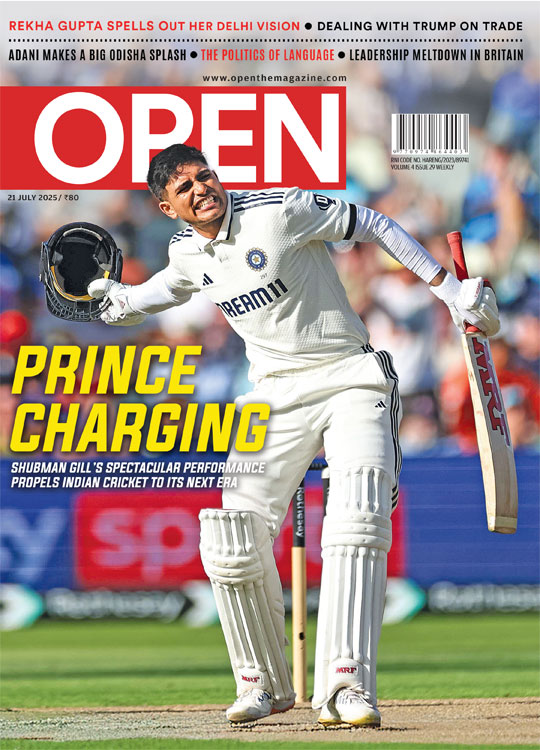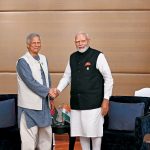Dented Trump
Hillary Clinton may have a slight advantage now but in its month-long denouement, the US presidential election is too close to call
 James Astill
James Astill
 James Astill
James Astill
 |
05 Oct, 2016
|
05 Oct, 2016
/wp-content/uploads/2016/10/Americavotes1.jpg)
THE SCENE I am about to describe really happened. I saw it with my own eyes, on a stormy night last week, at a small airport in Melbourne, central Florida. Before a crowd of 10,000 people (with thousands more shut outside), an obvious con-man stepped from his vast blue personalised jet, and just stood there, at the top of the wheelie steps, gazing at the sea of gaping mouths, the sparkling constellation of phone cameras, listening to the excited screams, the shouts of adulation, drinking in the crazed Trump-mania echoing around the hangar. It was like a visitation from a prophet, or even a Telugu film star.
I have been following this crazy presidential election for over a year now. I have watched Donald Trump speak a dozen times in seven states, have interviewed him at length in his Manhattan private office, and spent many hours watching him perform on television. I have written thousands of words about the rage that has inflamed America’s electorate, some of it justified by hard times and bad-faith politicians, much of it fuelled by an exaggerated view of America’s relative decline and the mass narcissism that a reality TV culture has engendered.
I also thoroughly appreciate how much most Americans dislike and distrust Hillary Clinton, Trump’s Democratic rival. But it still beggars my belief in America as a basically rational, decent place, that so many Americans could be so enthusiastic about the loutish Republican nominee.
The contrast between the hysteria apparent in Melbourne and the weary resignation evident among Hillary Clinton’s supporters is profound. A few weeks back, I saw Clinton address a rally in the suburbs of Orlando, an hour’s drive to the east. Her crowd was much smaller and less fired up. Her campaign organisers boasted that the venue was filled to capacity; this was only because half the available space had been judiciously closed off beforehand. But still, raucous rallies, while an important indicator of the enthusiasm Trump is engendering among his core supporters, are not everything. Clinton is drawing from a deeper pool of voters; compared to Trump’s, her supporters are more multi-ethnic, multi-generational and strategically located in the dozen or so competitive—or swing—states that will determine who wins on 8 November.
She also has a crutch for her lack of an inspiring message, a sure-fire way to corral millions of voters to the polls for her: Trump. The hero of Melbourne is by far the most detested major presidential candidate in US political history. Almost a third of his own supporters take a dim view of him.
For much of September, by his low standards, the star of The Apprentice actually behaved himself pretty well. Trailing Clinton by a big margin in the polls, in late August, he shook up his team, including by appointing a smart pollster, Kellyanne Conway, to be his third campaign manager in two months. He even listened to her advice.
He started sticking to the teleprompter and mostly refrained from filling his stump speeches with the eccentric ad hominem attacks that excite his wilder fans, but disconcert many more. He did not go out of his way to denigrate Hispanics, African Americans or Muslims, as he often has; he did not perform mocking impressions of disabled journalists, or threaten to smash the face of any protestor at his rallies. He was pretty nasty about Clinton; he suggested the persistent cough that had been bothering her was a sign of some dreadful disease. His spokeswoman suggested Clinton had brain damage. But Americans expect blood sport in their politics; and, in fact, it turned out Clinton really was sicker, with pneumonia, than she had been letting on.
She doesn’t have brain damage, unfortunately for Trump, but her illness helped confirmed many winnable independent voters in their view of the former First Lady and secretary of state as too frail and too dishonest to be president; and it made Trump look prescient. By the end of September, his prospects had improved markedly. The polls put him in a dead heat with Clinton, and ahead of her in a couple of important swing states, including Ohio and Florida.
But Trump’s less offensive performance couldn’t last: he is not a disciplined man (which is why the prospect of him laying his hand on America’s nuclear codes is so frightening). In his first televised debate with Clinton, which was watched by over 84 million people and took place the night before his rally in Melbourne, the showman showed his truer self.
Donald Trump needs, in short, not a miracle, but a fair wind, perhaps a stumble from Clinton, and above all, to restore his recent discipline
Asked why he had for so many years promoted a racist conspiracy theory that President Barack Obama had been born in Africa, not Hawaii, Trump flubbed and blathered. When Clinton suggested he had been paying no income tax, he appeared to admit the charge; he said this would only make him “smart”. He accused Clinton of “fighting ISIS her entire adult life”, which of course was absurd.
Flustered and irate, he then threw in a couple of jibes at a female comedian, Rosie O’Donnell, he had been feuding with; Trump has described her as a “pig”, a “degenerate”, a “slob”. This was more like the Trump we know, a man who promises to make America Great Again one moment then boasts about the size of his penis on live television the next. He sounded nasty and semi- deranged. In the ‘spin-room’ after the debate, as Clinton’s surrogates circulated among a crowd of journalists, they wore a look of almost disbelieving euphoria.
Almost everyone I spoke to in the crowd in Melbourne had watched this embarrassing performance, and almost as many acknowledged that Trump had not covered himself with glory. “He dropped the ball,” said Josh who described himself as a “professional hunter and fisherman” (though he also worked in shipping). But no one in that Trump-loving multitude, admitted to being remotely perturbed by this. There was no recognition of the obvious, that Trump had shown himself to be morally unfit for public office, or polite society, let alone the US presidency. “Hillary is the evil I know. I’m going to vote for evil I don’t know,” said a local lawyer. “… I hope I won’t be making a dreadful mistake.”
Trump’s bad form has endured into the days following the debate. Leaked tax records suggested he, a billionaire (or so he claims), might indeed have paid no income tax for almost 20 years. Across the country, if not with his hard-core supporters, his stumble has hurt him—but not as much as you might think. He is currently trailing Clinton by around three percentage points, which is just about within the margin for error.
He has also slipped in a couple of key swing states; having been ahead in Florida, the most important of all, without which Trump probably cannot win the president, he is now trailing Clinton by a point. But this still leaves him with a much more than trivial chance of victory. An eagerly-watched polling aggregator, designed by the respected data analyst Nate Silver, currently puts the chances of a Trump presidency at about one in three.
THE MAIN REASON for Trump’s better fortunes, despite his recent stumble, is that the disparate wings of the Republican coalition have started to unite behind him. Some of its constituent parts, including well-heeled moderates and business-minded free traders, never much cared for him. (How could they? He is a protectionist demagogue). Yet, rather than support Clinton, whom they loathe in a way that is longstanding but still easier to describe than explain, many Republican voters are swallowing their doubts and reconciling themselves to Trump anyhow. After decades of intense partisanship, party loyalty is trumping moral scruple.
Hillary Clinton has a crutch for her lack of an inspiring message, a sure-fire way to corral millions of voters to the polls for her: Trump
On the trail in a well-heeled suburb of Ohio, with campaigners for the local Republican Senate candidate, I felt I was watching this compromise being hammered out. As we moved door-to- door, seeking out undecided conservative voters, courtesy of the jazzy software that campaigners had on their smartphones, it was striking to hear cautious, respectable suburbanites work their way through the ethical minefield that a vote for Trump would entail. ‘I worry … but think he’s a good man… I guess he’s an honest man … I’d like him to cut out some of the extreme stuff… but he’s got a beautiful family … I guess I’ll vote for him,’ was the gist.
Trump’s share of the popular vote has climbed to around 41 per cent; Clinton has 44 per cent. That leaves around 15 per cent of voters undecided or planning, at least for now, to vote for one of the two also-ran candidates, Governor Gary Johnson, a sometime pot-smoking Libertarian, and Jill Stein, the presidential nominee of the Greens.
If Clinton were a more adept and popular campaigner than she is, she might already be said to hold a winning hand. She is about where Barack Obama was at the same point in 2012, and he ended up beating his Republican challenger Mitt Romney by four percentage points. And she should be a bigger beneficiary of the demographic changes that are gradually turning America blue than Obama was. The electorate is getting younger, better educated and less White with every cycle; and younger, educated and non-White Americans tend to vote Democratic.
True to form, Clinton is indeed winning with all these groups. The latest polls suggest she has a ten-point lead over Trump among younger voters, a 12 point lead among White college graduates and a handsome 77 point lead among Blacks. But she has two problems.
First, in most of these categories, and especially younger voters, many of whom have turned to Johnson and Dr Stein, Clinton’s lead is less than Obama’s was. And, second, the absence of much enthusiasm among her voters is driving concerns that not enough of them will actually show up to vote. Trump’s supporters mostly will; because Republican turnout is traditionally stronger than that among Democrats, as well as because of the relative zealousness of Trumpkins over Clintonistas. Both factors suggest the election is still too close to call.
To compensate for her particular weaknesses, Clinton needs to shore up her support, especially among women, with whom she is doing better than Obama did. And she needs to ensure her well-oiled, lavishly-funded campaign is in a position to turn out every potential vote. To that end, in Florida, Ohio, Pennsylvania and North Carolina, among one or two other swing states, it is currently bombarding the airwaves with advertising. Most of it, alas, is negative—a powerful new Clinton ad features a former Venezuelan Miss Universe, Alicia Machado, who Trump, as the then owner of the beauty pageant, publicly shamed as an “eating- machine” when she gained a little weight.
For his part, to buck up his chances, Trump needs not only to maintain the high enthusiasm levels among his core voters; he probably also needs to find some additional ones. Given that his reputation among non-Whites is appalling, this would mainly mean eating into Clinton’s lead with the many college-educated Whites and women he has driven to the left with his troubling behaviour. Trump needs, in short, not a miracle, but a fair wind, perhaps a stumble from Clinton, and above all, to restore his recent discipline. How hard can that be? He has a clear message, of economic populism, which has found favour with the electorate. He has at last a talented campaign team. He has enough money to finish the job. He just needs to watch his behaviour for a month or so. Surely even he could manage that?
Yet, the evidence, sadly for Trump fans, is not encouraging. Consider, for example, his response to the Machado attack, which Clinton heralded by highlighting Trump’s treatment of the former beauty queen in the TV debate. In a flurry of late night tweets last week, starting at 3 am, Trump derided Machado as a “con”, the “worst”, “disgusting”, and recommended his 12 million followers check out her “sex tape”.
It seems such a tape may not exist (Trump was probably referring to some racy, very grainy, footage of Machado filmed during a reality television programme). It did emerge, however, in the kerfuffle this caused, that Trump had himself briefly appeared in a soft porn movie. It apparently featured him spraying a Playboy- branded car with champagne, before cutting to footage of naked women rubbing themselves with honey. Oh my.
What a time it is to be alive in the land of Jefferson, Lincoln and Roosevelt.

/wp-content/uploads/2025/07/Cover-Shubman-Gill-1.jpg)













More Columns
‘Fuel to Air India plane was cut off before crash’ Open
Shubhanshu Shukla Return Date Set For July 14 Open
Rhythm Streets Aditya Mani Jha